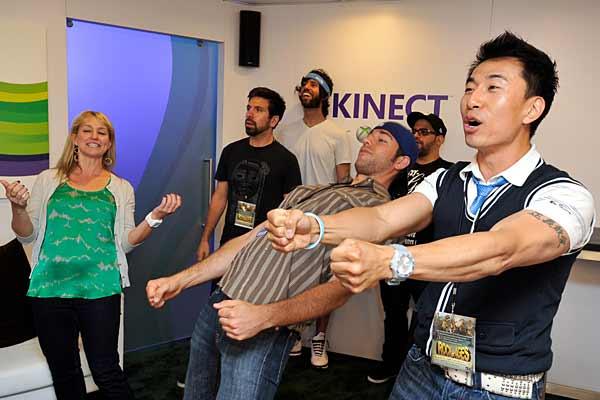 Microsoft will unveil three new games for its Kinect device tomorrow at the Electronic Entertainment Expo in Los Angeles — one of which will literally be a trip to Disneyland.
Microsoft will unveil three new games for its Kinect device tomorrow at the Electronic Entertainment Expo in Los Angeles — one of which will literally be a trip to Disneyland.
The game will let players take a virtual tour of a carbon copy of Disneyland, a popular theme park in California that features Disney characters like Mickey Mouse and Donald Duck. Microsoft has rebuilt the whole experience of visiting the Magic Kingdom piece for piece, except for one small difference — players can fly through Disneyland instead of walking.
It’s one of the new ways players can interact with games since the advent of motion-controlled gaming. Nintendo’s Wii was the first console to popularize motion-controlled gaming by giving players a remote-and-nunchuk combination to control games like The Legend of Zelda. It was a risky move, but the gambit proved successful in making motion-controlled gaming more appealing to mainstream audiences because it was much more immersive than using typical controllers.
Microsoft is pulling out all the stops to make sure the Kinect is as appealing as possible to just about every audience. The Wii was successful initially because it was able to hit both casual audiences with games like Wii Sports and hardcore audiences with games like The Legend of Zelda: Twilight Princess. Most games for the Kinect, like dancing game Dance Central, have been more appealing for casual gamers — but that’s poised to change at E3 this year with the presence of games like Child of Eden and the new Star Wars title.
The Kinect is a strong part of Microsoft’s portfolio and has been a large factor in the company’s recent success. Revenues from Microsoft’s entertainment and devices division was up 60 percent to $1.9 billion in the third fiscal quarter this year, from $1.2 billion in the third quarter last year. Revenue rose 13 percent to $16.4 billion, up from $14.5 billion in the same quarter a year earlier.
The Disneyland adventure game looks like it will be less of a “game” and more of an “experience,” which is what Microsoft is trying to evoke by immersing gamers even further with motion-controlled gaming. The company has tried to market its Kinect motion controller as an experience by giving Xbox 360 owners ways to control other parts of their Xbox 360 with motion controls — like the menus in the console’s dashboard that let owners access popular applications like Hulu and Netflix.
Microsoft will also launch a long-expected Star Wars game that will let Kinect owners control characters in the Star Wars with their own bodies. That means they’ll be able to swing around Lightsabers — the iconic sword of the mystical Jedi in the Star Wars universe — and use magic-like Force abilities within the game. Most Star Wars fans (myself included) have been gunning for a proper motion-controlled Star Wars game that features decent swordplay since motion-controlled gaming became popular. That shows that motion-controlled gaming can appeal to hardcore gaming audiences as well as more casual audiences.
The Xbox manufacturer is also targeting children with its Kinect motion controller by releasing a game that lets kids and their parents dive into the world of Sesame Street. Players can interact with characters in the Sesame Street universe, which is populated by puppets like Elmo and Cookie Monster — both of which are iconic images in children’s entertainment.
VentureBeat's mission is to be a digital town square for technical decision-makers to gain knowledge about transformative enterprise technology and transact. Learn More
